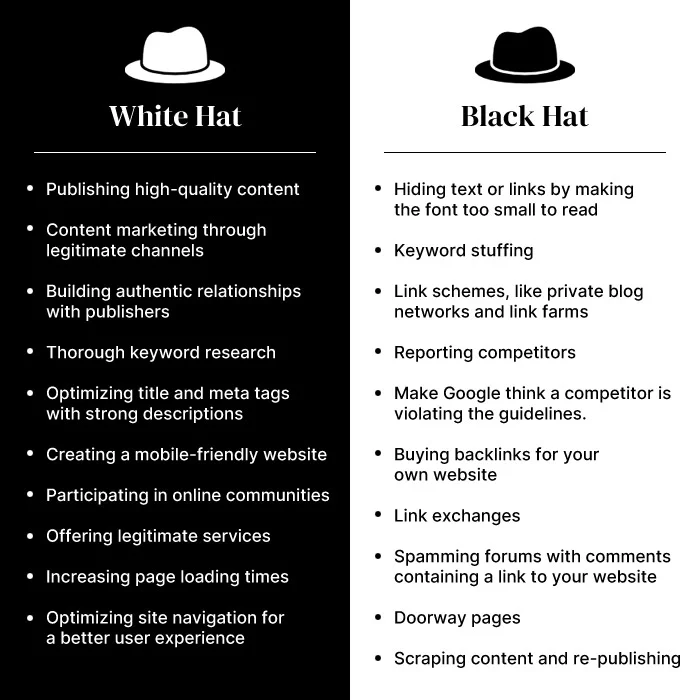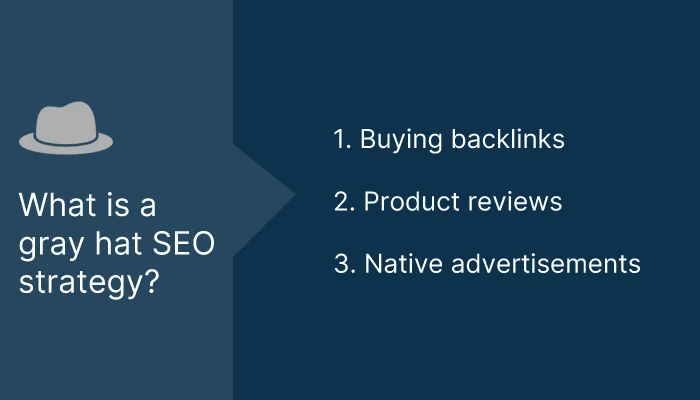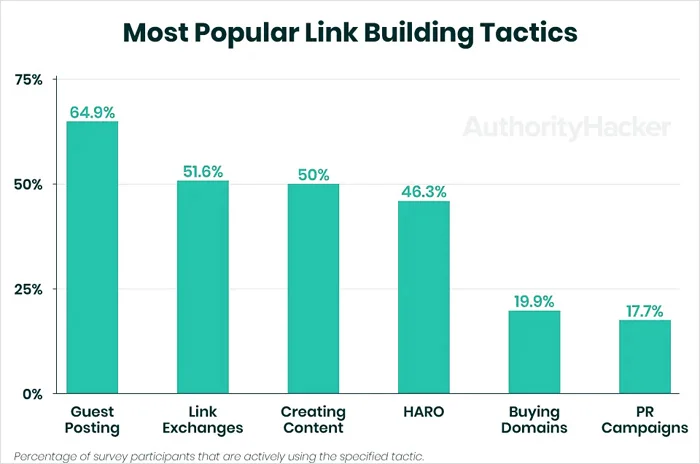Gray Hat Link Building for SEO – Is It Beneficial or Off-Limits?

When optimizing your website for search engines, there are two general methods: white hat and black hat. White hat SEO techniques are acceptable and effective, while black hat strategies are harmful, considered unethical, and go against Google’s terms. Some link building strategies fall into the category of gray hat, which is somewhere in the middle, but still tend to be a bit questionable.
If you’re wondering how to approach gray hat link building, this article will help you make the right decisions.
First, to understand what you’re getting into when you choose gray hat SEO techniques, it’s essential to fully comprehend what makes strategies white hat vs. black hat.

What makes an SEO strategy white hat?
A white hat SEO technique follows Google’s guidelines, maintains the integrity of your website, and is otherwise ethical. These strategies focus on long-term results by prioritizing the user experience. Several examples include:
- Publishing high-quality, authoritative content.
- Content marketing through legitimate channels.
- Building authentic relationships with publishers.
- Thorough keyword research.
- Optimizing titles and meta tags with strong descriptions.
- Creating a mobile-friendly website.
- Participating in online communities.
- Offering legitimate services.
- Increasing page loading times.
- Optimizing site navigation for a better user experience.
- Building backlinks through genuine connections.
- Generating backlinks organically from irresistible content.
It goes against Google’s guidelines to manipulate search rankings, but since these techniques center on increasing value and supporting users, they aren’t considered a violation. With these strategies, an increase in ranking is the result of creating value.
All of these strategies work, but it takes time and a serious commitment to see results. The time required to get big results is usually the reason brands resort to black hat SEO tactics.
What makes an SEO strategy black hat?
Black hat SEO consists of deceptive techniques specifically designed to manipulate a website’s ranking in the search results without regard for the user. These strategies produce short-term results and act as a shortcut to avoid doing all the hard work required to rank legitimately by providing value.
Black hat techniques can get your entire domain blacklisted from Google if you’re not careful. Here are some examples:
- Hiding text or links by making the font too small to read and the same color as the background.
- Keyword stuffing.
- Link schemes, like private blog networks and link farms.
- Reporting competitors.
- Using black hat SEO techniques to make Google think a competitor is violating the guidelines. For example, buying 10,000 ultra-spammy backlinks to a competitor’s website.
- Buying backlinks for your own website.
- Link exchanges.
- Spamming forums and blogs with comments containing a link to your website.
- Doorway pages.
- Scraping content and re-publishing.
- Plagiarizing/stealing content.
- Sneaky redirects.
All of these strategies violate Google’s Webmaster Guidelines. They are attempts at circumventing the process of creating value for users. While some of these strategies can produce immediate results, they don’t usually last long and require constant effort and capital to maintain. For example, if you buy backlinks in bulk from spammy sources that publish to blog networks, they’ll disappear when Google finally removes those sites from their index.
When you lose those links, your rankings will drop, and then you’ll have to buy more links. It won’t stop there. You’ll need to continue buying thousands of backlinks on a regular basis to bring your web pages back up in the results pages each time Google nukes your link sources.
What is a gray hat SEO strategy?

Grey hat SEO techniques fall between black and white. They may not specifically violate Google’s guidelines, but they push some boundaries, ride the line, leverage loopholes, and can be ethically ambiguous.
Like black hat techniques, gray hat SEO techniques often produce short-term results and are rarely sustainable. There’s also a chance that today’s gray area might become tomorrow’s black hat tactic when search engines update their policies. If Google discovers any ambiguous strategies that are manipulative, you bet they’re going to close those loopholes.
Although some gray hat techniques aren’t technically a violation, they can still be interpreted as such by search engine guidelines. Anything that looks artificial carries this potential.
Here are some examples of some common gray hat link building tactics:
1. Buying backlinks
Exchanging money for backlinks is against Google’s policies. However, most brands get around this by paying to get an article published on a third-party website that contains a backlink to their website. They aren’t paying for the link – they’re paying for the sponsored article just like any other advertiser would pay for a banner ad that links to their website. Acquiring backlinks this way appears natural to Google and other search engines and is highly unlikely to get penalized.
Where grey hat link building crosses over into black hat is when you establish collaborations or partnerships with other brands, and a link exchange is part of the deal. This is an indirect way to buy links, and it goes against Google’s guidelines.
2. Product reviews
Many brands reach out to bloggers in their niche and send them a free product or service to review. The company then asks the blogger to link to their website, and this earns them a nice backlink that will help them rank in the search engines. The problem with using online reviews for link building is that Google says it’s a violation of their guidelines because these links aren’t organic. This technique is considered exchanging goods and services for links and is considered a link scheme.
Back in 2016, Google announced that bloggers who publish links in reviews must use the nofollow tag to avoid passing PageRank to the brand’s website. Links that pass PageRank cannot be purchased with money, goods, or services directly or indirectly. This completely eliminates the SEO benefit of getting linked reviews from bloggers. However, those reviews will still give you traffic.
How does Google determine whether you’ve asked a blogger for a link or if they just link your site on their own? Technically, it doesn’t matter because it’s still a compensated exchange. Many brands disguise paid links as natural reviews, so Google will potentially crack down on every instance. It’s all about intent here. If your backlinks appear to be generated through an exchange of goods, services, or money, the intent is interpreted as manipulation.
There’s nothing wrong with generating nofollow backlinks. Traffic is valuable and can absolutely increase your revenue. Where things get risky is that bloggers don’t usually know they need to make review links nofollow. Some bloggers don’t even know what that means and can’t be bothered to learn. Unfortunately, the person who will be punished for this violation is the brand, not the blogger. You can’t rely on bloggers to make your links nofollow, and since most of them won’t, it’s a risky tactic.
3. Native advertisements
A native advertisement is an ad that appears in the content of your website. These ads have existed for decades, but they cross the line into gray hat territory when not properly disclosed.
Native ads might show up as promotional articles or an actual ad in the middle of a blog post. Since Google uses intent to determine violations, it’s critical to disclose any affiliation with the brands you promote in any way.
Should you use gray hat SEO link building tactics?
SEO techniques themselves are not white, black, or gray hat – it’s all about how they’re used. Every SEO strategy has the potential to become a gray hat tactic when abused. For instance, building backlinks is an integral part of SEO, but farming links from spammy sites makes it black hat. Generating backlinks naturally from authoritative websites in your niche is white hat.
Hopefully, you already know that black hat SEO should be completely avoided, but is it ever okay to use gray hat link building strategies? Is it really that much of a risk? Ultimately, you’ll get the best results by engaging in white hat SEO strategies that focus on delivering massive value to your audience. Doing SEO right is a long-term, ongoing process, and you won’t see immediate results.
You need patience and commitment to get worthwhile results. However, if you engage in some gray hat link building, you might get some results and fly under Google’s radar. The problem is that you’ll never know if the next major algorithm update might render your backlinks worthless. Is it worth the risk? Probably not.
How to avoid risky link building tactics
To avoid getting caught up in unethical, black hat, or gray hat link building practices, here are some general guidelines to follow.
- Stop generating artificial links ASAP. The sooner you stop, the easier it will be to turn your link building efforts to white hat strategies.
- Disavow existing sketchy links. If you purchased a bunch of links that you’ve realized are spam, or if a competitor has done this to hurt your rankings, you can disavow harmful backlinks and tell Google to ignore them.
- Never pay for a link. If paying for links is the only way you can get them, it might be time to rethink things. Although big brands do have impressive backlink profiles, most have earned those links through doing the hard work. There is no shortcut to getting (and staying) on the first page of Google.
- Focus on building your authority. Are you considered an expert in your niche? One of the fastest ways to get natural backlinks is to post authoritative content that other people will naturally link as a resource. The better your content, the more likely you are to get backlinks.
Need a better link building strategy? We can help!

Are you trying to figure out how to get high-quality backlinks that will increase your ranking in search results? Are you tempted to use black or gray hat SEO tactics just to gain some traction, but you’re afraid of getting penalized? If you’re not sure how to proceed, Link.Build can help. Our SEO experts will analyze your existing backlink profile and identify potentially harmful links. We’ll help you get them removed or disavowed so you can start building a natural backlink profile for your brand using the white hat strategies that get big results.
If you’re ready to work with a professional link building agency, reach out to us for more information about our services. We’d love to help you get the search rankings you deserve.


.svg)

.jpg)
.jpg)
.jpg)